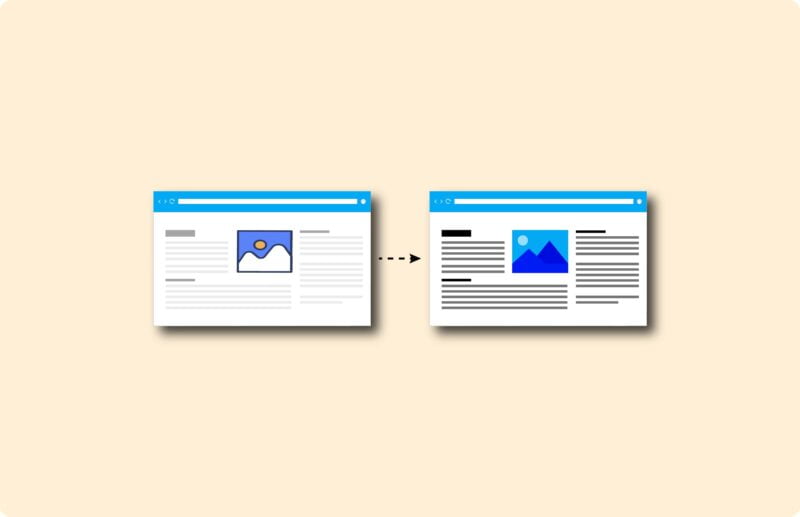What is prerendering (for SEO)?

Prerendering is a powerful technique for improving the loading speed of Web pages. This is essential in the dynamic world of web development and digital marketing.
In this article, I outline the steps to apply prerendering effectively, with the main points being increasing website speed and accessibility.
The benefits of prerendering
In prerendering, a web page is pre-loaded and executed. This happens even before the user requests it. So the page is already fully rendered on the server. Once the visitor opens the URL, the page is immediately displayed. Prerending primarily provides faster load times and a better user experience.
- How it works: where the browser normally loads the website only when a user enters a URL or clicks on a link, prerendering ensures that a website is rendered in advance. HTML, CSS, JavaScript and other resources from the server are retrieved even before a website is opened. So when a user requests access to the page, most parts of the page are already loaded and displayed immediately.
- Benefits to user experience and load times: prereading reduces and improves load times. Because the page is pre-rendered, less time and resources are required to load and render the page in the user’s browser. So the user accesses the content faster and improves the user experience. Faster load times can also improve SEO.
- Benefits for SEO: Search engines prefer fast-loading websites. Prerendering, then, causes a website to rank higher in Google. Also, prerendering ensures that certain JavaScript frameworks are rendered before being served to Googlebot.

When is prerendering interesting?
Prerendering is especially appropriate in cases where speed and immediate accessibility are essential. These include high-traffic websites. In this regard, every second of loading time impacts user experience and conversion rates. Prerendering can also be useful for pages with complex or heavy content. Consider websites with large images or sophisticated scripts that often have slow load times.
- High traffic websites: for high traffic websites, including popular news websites, large blog or online stores, load time has a big impact on the user experience. Every second counts here. Prendering can help distribute the server load to better manage peaks.
- E-commerce platforms: prerendering is also useful for online stores where conversion is tied directly to the user experience. Faster load times improve the user experience and allow (potential) customers to move through the various stages of the purchase process faster without getting frustrated by slow load times.
- Interactive websites: prerendering is also useful for websites with many heavy or complex elements – think games, online tools or interactive data visualizations. These websites often take longer to load. Prerendering can significantly reduce loading time.

When is prerendering not appropriate?
If websites depend on real-time data or personalized user experience, prerendering is less appropriate. If content changes dynamically based on user interactions or preferences, prerendering can be problematic. Because content is preloaded, outdated or irrelevant information may be displayed.
Example: on a news website, headlines and stories are updated every hour. In this case, prendering may display information that is already out of date when the user visits the page.
Even on an e-commerce website with personalized product recommendations based on user behavior, prerendering is not appropriate. In fact, the recommendations should change as soon as the user interacts with the website.
Implementing prerendering also puts additional strain on the server because it requires fewer resources to pre-process the pages. This can be a barrier for smaller Web sites or businesses with limited server capacity. Additional server usage can incur higher costs and reduce a Web site’s performance. This affects both user experience and SEO position.
So always weigh the benefits of prerendering against the specific needs and dynamics of a Web site. For websites with dynamic content or limited server resources, alternatives to prerendering are often better suited for improving loading speed and user experience. Think lazy loading or asynchronous JavaScript.
Prerendering versus client/server/dynamic rendering
To know whether prerendering or client, server or dynamic rendering is most appropriate, you need to make good trade-offs. Often this is a matter of customization. To get an idea, I explain the standard scenarios below.
Prerendering versus server-side rendering
With server-side rendering, an entire page is generated on the server before it is sent to the browser. This is effective for SEO because search engines easily crawl and index the pages. Prerendering loads and renders the page in advance. This makes the content immediately available when a user requests the page.
The big difference is in the timing of the rendering. The server-side rendering is rendered at each user request, while the page is pre-rendered at prerendering.
Prerendering versus client side rendering
Client side rendering differs significantly from prerendering. Client side rendering ensures that content is generated by the user’s browser, usually through JavaScript. The page is dynamically loaded and rendered. This provides flexibility for interactive websites. However, this does have drawbacks for SEO because search engines find it difficult to index this content.
Prerendering can solve the above problem by pre-loading the page so that the content is immediately accessible to users and search engines.
Prendering versus dynamic rendering
Dynamic rendering provides a middle ground between server-side and client-side rendering. This technique is just as flexible as client side rendering, but has better SEO capabilities.
In dynamic rendering, the server chooses whether to render the content server-side or client-side based on the user type – a search engine or a person.
Prendering does not consider the type of user. Therefore, prerendering is easier to implement but less flexible than dynamic rendering.
The differences
The table below clearly shows the differences between prerendering, server-side rendering, client-side rendering and dynamic rendering.
| Rendering Type | Description | SEO | User Experience |
|---|---|---|---|
| Prerendering | Loads and renders the page in advance, making the content immediately available upon user request. | Good for SEO | Fast loading times |
| Serverside Rendering | Generates the full page on the server with each user request, beneficial for SEO. | Excellent for SEO | Depending on server capacity |
| Clientside Rendering | Renders content in the user’s browser, usually with JavaScript, provides flexibility for interactive sites. | Less beneficial for SEO | Dynamic, interactive experience |
| Dynamic Rendering | Chooses based on user type whether content is rendered server-side or client-side, a balance between flexibility and SEO. | Balancing flexibility and SEO | Adapted to user type |
My roadmap for prerendering
Previously, development was necessary for setting for prerendering. Nowadays, various tools make prerendering easier and easier. I usually use https://prerender.io/ for this purpose.
Step 1: Analyze the need for prerendering
- Rate a website: look at a website’s current load times and user experience. See which pages benefit from faster load times.
- Analyze traffic: find out the traffic pattern of the website. See if there are peak times when loading speed becomes a bottleneck and address this page.
Step 2: Determine which prerendering tool is appropriate
- Check out the options available: there are several prerendering tools and services available. Choose the tool that best fits the technical specifications, taking into account the organizations budget.
- Test compatibility: the chosen tool must be compatible with the web infrastructure and content management systems.
Step 3: Implementation planning
- Create an implementation schedule: define a timeline for implementing prerendering. Consider whether this approach should be phased or not.
- Technical preparation: together with the web development team, prepare the necessary technical adjustments.
Step 4: Implement prerendering
- Configure the chosen tool: set up the prerendering tool, keeping in mind a website’s specifications.
- Test on a small number of pages: implement prerendering first on a small number of pages to test the effect.
Step 5: Analysis and adaptation
- Analyze performance: use analytics tools to measure and analyze the impact of prerendering on load times and user experience.
- Make changes: based on the data collected and feedback, review whether any adjustments are needed.
Step 6: Rollout and continuous monitoring
- Implement more pages: if the initial results are positive, the prerendering can be expanded to more pages.
- Keep monitoring and improving: keep monitoring continuously to maximize the benefits of prerendering. Ensure compatibility with future website updates.
Step 7: Evaluation and feedback
- Evaluate the effect: assess the effect of prerendering on SEO and user experience.
- Gather feedback from users: user feedback is valuable to the SEO roadmap. Based on this, any changes can be made.

SEO experts use the above roadmap to make prerendering more successful. Load times will be faster and the user experience will be improved.
Summary
Implementing prerendering can greatly reduce load times and thus enhance the user experience. Using the above roadmap, organizations can optimize their websites not only in terms of loading time, but also in terms of SEO. As a result, the page will rank higher in Google.
However, the right approach is important. Only in this way does prerendering become valuable to the overall digital strategy.






